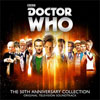Original 2005 DVD Extras include:
- Audio commentary by actors Katy Manning (Jo Grant),
Richard Franklin (Capt. Mike Yates),
and producer Barry Letts.
- Interview with director Michael Ferguson (15 min.).
- "Reverse Standards Conversion" special in-depth restoration featurette (10 min.)
[not advertised on the Special Edition]
- "Now and Then" Location featurette (6 min.)
- Raw studio footage featuring bloopers, deleted and extended scenes
in full colour and top quality (27 min.)
[this version also included in Special Edition]
- Pop-up Production Note Subtitles for main feature
- Pop-up Production Note Subtitles for raw footage
[also included in Special Edition]
- Photo Gallery sound effects montage (11 min.)
2012 Special Edition DVD extras add:
- NTSC colour & PAL BW film recombination restoration
on episodes 2 & 3.
- "Axon Stations!" making-of featurette (26 min.),
with Manning, Ferguson,
co-writer Bob Baker,
script editor Terrance Dicks,
Paul Grist (Bill Filer),
Bernard Holley (Axon Man & Voice of Axos),
and Derek Ware (Pigbin Josh & Havoc stunt leader).
- extended (full length) raw studio footage reel (73 min.)
- "Living with Levene" featurette (35 min.),
with John Levene (Sgt. Benton).
In-Depth Analysis Review
by Martin Izsak
|
|
WARNING: This review contains "SPOILERS", and is intended for
those who have already seen the program. To avoid the spoilers,
read the Buyers' Guide version instead.
|
This adventure commits many obvious cinematic no-no's and may drop
to the bottom of many a film-savvy fan-reviewer's list, but in some
strange way it is the one story of season eight
that appeals to my personal tastes the most. The high quantity of
video trickery and special effects being pioneered and attempted
on this production provide lots of eye-candy, giving it a
"repeat viewing potential" similar to a Star Wars film.
The story's fast pace is at times only superficial, particularly in
the beginning.
The editing is fast; we cut back and forth between scenes fairly
quickly. But since we often don't get any meat in these short scenes,
the plot still advances fairly slowly. Dialogue is not great at times,
and characters are fairly archetypal and thin.
But in its own fumble about
way, there actually are some new scientific concepts getting explored
in this story, not just demonstrated for the kiddies, but explored.
Hallelujah, true sci-fi at last! The adventure also feels to be
the most Who-ish of the season, making up for earlier shortcomings
with a well-constructed climactic conclusion, and redefining
forever the way the TARDIS should be used and portrayed in a story.
The Bristol Boys, also known as writers Bob Baker and Dave Martin,
have come home to roost! Let's party.
At first, introductions seem to work. The Axos spacecraft
gets its due, followed by the Brigadier being confronted by an
official named Chinn who digs deep into the mystery of exactly
Who the Doctor is. Excellent!
But, before Chinn can draw out any answers
to inform the uninformed in the audience, before the all-knowing fan
can get a good humorous scene, we starting cutting all over the place,
flipping through more characters than we need to see at this stage
uttering inane remarks in the middle of their own private conversations.
Jo Grant, Bill Filer, Mike Yates, and Sgt. Benton are all thrown
in on top of the Doctor's defining scene before Jon Pertwee has had
a fair go at making himself known, and relevant references to the
Master and the search for him are lost in amongst irrelevant
references to Errol Flynn - dialogue like this depends on a person
being familiar with other specific cultural works, and always detract
from a story's ability to be appreciated independently. Even if one
is going to get away with references to characters not in the story,
the time for it is not at the very beginning when the audience is only
just starting to get a grasp of the characters who actually are in
the story at hand!
In this respect, the UFO story beats affect the UNIT group
way too early. Chinn's investigation is rankling enough to sustain
itself for a good ten minutes, while an exploration of the Doctor's
background, a better introduction of Bill Filer and his motives, and
a brief description of the Master's infamy, could all be given their
due.
As it stands, this story flips back and forth between all these
things indiscriminately like a child with a short attention span,
depending on an audience that knows all that previous stories have
dished out, and failing to do proper justice to any of it. There's
a fair share of poor quality "techno-babble" in the opening as
well, and it's pretty much a waste of screen time, particularly as
so many of the basics aren't getting covered properly.
The DVD releases reveal that there actually was footage shot to take
care of some of the points I raised above, most notably
introducing Bill Filer and Jo Grant, and much of this footage
deserved to be
in the final version more than the "techno-babble" moments,
but even then, something's still missing to make the story's
beginning come together properly.
The seaside
tramp actually gets a much better introduction than a stand-by
sacrificial extra deserves, and although this also gives us the
setting for Axos' landing area, the quantity of screen time is
not justified, nor is it a display of character that makes any
particular sense or humour.
Later on, two more scientist characters join our group, and
they too are crammed upon us, making their debuts in a tiny set
and with even tinier camera angles. We are meant to notice each
person while someone else talks about him, and when this flips
by in a series of quick close-ups, it aids an aura that we're
missing something important somewhere.
Despite this shaky beginning, the story gradually improves
and develops from inanity to excellence. If the regulars and
human guest stars are meant to be passed by quickly as known
quantities, the Axons are definitely unknown quantities and
get their due introductions as they are investigated - in
dialogue and in demonstration. The Axon spacecraft is nicely
weird and filmed well as our explorers make their way into it
and through it, and the first contact scenes with the Axons
are some of the best in the story.
Refreshingly, the Master's motivations are the clearest
yet on the series, and the script gives him plenty of screen
time to make it so. By this time (his third appearance in "Doctor Who"),
there is enough history between
the Master and the Earth for him to want revenge on it as well as on
the Doctor, but these are only bonus goals of secondary importance
to him. His main ambition is to regain his previous freedom,
nicely symbolized by having him come out of tendril "chains"
for his intro, and ultimately requiring access to his TARDIS,
or someone else's..... This time the Master is simply in
trouble and going to dastardly lengths to get out of it.
Good job. He flips loyalties between the Axons, the Brigadier,
and the Doctor at several points throughout the story, and it
is perfectly believable because it clearly is the secondary goals
that he doesn't care too much about that get sacrificed, while his
main ambition remains constant. Another unique element is the
fact that the Master and the Brigadier get to square off face to
face for a good portion of episodes three and four, something I don't
think any other story comes close to delivering.
|
Dudley Simpson's musical score is typical of the season and remains
interesting - most of the nicest "Master" tracks developed throughout
the last two stories make a return, and a few new pieces are
actually worthy of becoming memorable, such as a fast pace
"action" track played over scenes of the Axon spacecraft's
descent being tracked by Earth people (repeated as the Brigadier
escapes custody at the end of episode two) and, on the lighter
side of things, the music for the seaside tramp. Included on the
recent "70's Era" BBC Radiophonic Workshop CD,
the track entitled "The Axons Approach"
is not a particularly great one - but it does get used twice
in the story during action scenes in episodes three and four.
I suppose we're lucky that that much of the original recordings
of the score has still survived.
Jon Pertwee is in fine form playing the Doctor in this one,
and our hero can be perfectly proud of his role. While his
entrance may be lacking in dialogue and screen time, he is
himself at his best all the way through. Faced with the unknown,
he assumes the best of the Axons and argues for a peaceful,
diplomatic approach. When their story shows a few holes, he
alone becomes skeptical and immune to the greed that his fellow
explorers fall victim to. His scientific investigations in
episode two reveal critical character elements of the Axons,
moving the plot firmly to its next stage. Episode three has
him playing prisoner throughout, but this is used wisely to
confront the new villains of the piece, to exchange and debate
more scientific concepts, and to dig deeper into the villains'
character, motivations, and ever-increasing ambitions. Jo has
little to do here apart from getting aged - not a bad idea, but
not particularly impressive either.
Finally armed with the complete truth in the final episode,
the Doctor uses his charm and diplomatic skill to pull off a few
bluffs, and his technical skills and inventiveness to perform
the final climactic heroic acts all on his own. Extremely
satisfying.
|
Music by Dudley Simpson, sound by Brian Hodgson
"The Master's Theme",
"The Axons Approach",
"Brain Centre Atmosphere", and
"TARDIS Lands" (THE definitive version)
are available on:
|
"The Master's Theme",
"The Axons Approach",
"Hypnosis Music", and
"Copy machine tickover"
are available on:
|
All of the above tracks, plus
"Axos Cell Interior Atmosphere"
can be found on:
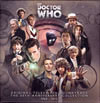 |
Audio CD -
Doctor Who:
The 50th Anniversary Collection
11-disc version (2014)
More info
|
|
|
It should be noted that this is the first story of the colour
& Jon Pertwee eras to feature the TARDIS interior.... better late
than never I suppose. Its introduction in episode three lacks
the clarity it should have - the scene of the Master entering the
police box could easily have been directly juxtaposed with the scene
of him discovering the mess in the console room to demonstrate things
properly, but rather idiotically something completely unrelated gets
dropped in between these. There is enough movement into and out of
the TARDIS to get the right idea across later on though, with a
particularly good example at the beginning of episode four.
Also, the good old police box starts wheezing and groaning
and popping in and out all over the place in the final episode,
thanks to the Master's repairs. "Short hops" are practically
born here in this story, a practice shunned earlier in the series
to add credence to the Doctor's lack of control over the machine
and keep his Earthly companions on their never-ending odysseys.
Thankfully the change of rules and series' goals has opened up
a wonderful new Pandora's Box of possibilities. And even when
standing completely still, the TARDIS has plenty to do in the
lab in episode three, wired up into a power battle with the Axon
spacecraft. Nice stuff; great imagination. Many similar ideas
have popped up in Doctor Who since, but you saw it here first.
Last but not least, the production team finally arrives at the
sound effect for the TARDIS landing that has served the show ever
since and become almost as famous as the theme tune. The original
sound is reversed, the first (now final) wheeze is lopped off
with a good thud, and no extra echo effects wash in to ruin things.
Too bad it took eight years to figure it out, but better late
than never! The next challenge seems to have been figuring out
how to cue it into the story - the first attempt during
rematerialization in the lab had to have a nasty restart,
but the following landing on location filming gets everything
perfect. Top marks.
This is director Michael Ferguson's fourth and final
Doctor Who story,
and on the whole it ranks as an average outing for him - mostly solid
material with a few innovative new tricks all other directors will copy
from now on, and a few "faux pas" for others to avoid.
"The War Machines" (story no. 27)
is still his best, and
"The Ambassadors of Death" (story no. 53)
ranks second ahead of "Claws of Axos".
"The Seeds of Death" (story no. 48) easily
falls to the bottom of the pile, no questions asked. Like all
of his stories, "Claws of Axos" betrays a transitional style
where suspense ought to be, this time most notably at the end
during the evacuation of the Nuton power complex. We get lots of
footage of people moving from A to B without anything happening along
the way, while the music is relied upon to supply the mood. Others
might easily have used less footage here, and given Benton and Yates
or some other characters a bit more screen time for close-ups,
reaction shots, etc., to let a mood linger on their scenes a
little longer and make them appear as more rounded characters.
Conversions, Extra Features, and the Special Edition
I'm not sure what this story has done to deserve a
special edition DVD now on top of its regular release. It's
probably more a case of the Restoration Team wanting to feel
finished by using its latest, more thorough method of restoring
episodes two and three, now that they can afford it. Sure, the original
didn't have a dedicated making-of featurette, but you could kind of
get the same content and effect by watching the location featurette
first, followed by the director's interview, then the studio footage
and various commentaries, finally topping the experience off with the
"Reverse Standards Conversion" featurette. Contrary to one reviewer
on Amazon, I found this last featurette quite fascinating and of
interest even to any non-Doctor Who viewer
who has ever wondered exactly what the differences between
North American and European television signals were, what the
challenges were in converting between them, and what ingenious
technologies were used to convert between them before computers
became commonplace. I understand this featurette is hidden on the
Special Edition version as a DVD Easter Egg, since it no longer applies
directly to the restoration carried out on this version.
Of course, one thing that this featurette fails to take into account
after bemoaning the loss of quality that episodes two and three suffer
after being converted from PAL to NTSC and back to PAL from the tapes
returned to the BBC from TVOntario, is that the finished restored
episodes, no matter how good the restoration work is, are then
converted from PAL to NTSC again for its latest North American
release. Which makes me wonder if OUR final North American version
wouldn't be best arrived at by sampling the TVOntario tapes directly
and skipping two redundant conversion passes? Food for thought.
Personally, I'm not sure I'd notice the difference after getting
caught up in story as I usually do; the original release seemed
fine enough to me, and I'm not sure additional restoration work
on the Special Edition will even register after the signal is
processed back to NTSC for the North American release. I really enjoy
this Doctor Who story, and its original DVD release, but I won't be
in any hurry to double-dip on the Special Edition. In fact, the
special features on the original may just turn out to be the more
concise, non-repetitive, and more enjoyable ones. Then again,
adding the perspectives of Bernard Holley, Paul Grist,
and one of my favourite writers Bob Baker makes the new
documentary tempting, and Terrance Dicks' presence is
always a treat....
All in all, season eight has produced yet another story that
is difficult to rank as a whole. The final episode is bar-none
my favourite half-hour of the entire season, but the beginning
of the story is far too clumsy to hold a candle to what most of
the
rest of season eight has to offer. My opinion remains split.
Final Line: "It seems that I'm some kind of a galactic Yo-yo!"
Rating: Classic! Fans everywhere remember this one, especially
as it so expertly describes the latter half
of the Doctor's exile on Earth.
International Titles:
Deutsch: (Die Klauen von Axos)
Magyar: "Axos karmai"
Français: (Les griffes d'Axos) ou (Les pinces d'Axos)
Русский: "Когти аксонов"
This story has become available on DVD and VHS video:
Original 2005 release:
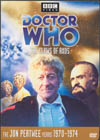 |
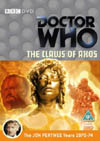 |
 |
DVD NTSC Region 1
for North America:

 in the U.S.
in the U.S.

 in Canada
in Canada |
DVD PAL Region 2

 for the U.K.
for the U.K. |
VHS Video
NTSC

 in the U.S.
in the U.S.
PAL

 for the U.K.
for the U.K.
|
|
|
Special Edition 2012 re-release:
|
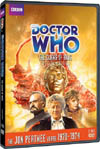 |
 |
DVD NTSC Region 1
for the North American market:

 in the U.S.
in the U.S.

 in Canada
in Canada
|
DVD PAL Region 2

 for the U.K.
for the U.K.
|
|
Additional DVD extras include:
- NTSC colour & PAL BW film recombination restoration
on parts 2 & 3.
- "Axon Stations!" making-of featurette (26 min.),
with Katy Manning (Jo Grant),
director Michael Ferguson,
co-writer Bob Baker,
script editor Terrance Dicks,
Paul Grist (Bill Filer),
Bernard Holley (Axon Man & Voice of Axos),
and Derek Ware (Pigbin Josh & Havoc stunt leader).
- extended (full length) raw studio footage reel (73 min.)
- "Living with [John] Levene" (Sgt. Benton) featurette (35 min.)
|
|
Comments on this article are welcome. You may contact
the author from this page:
Contact page
|







